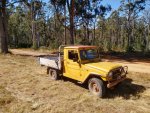Definitely understood. In my case, I don't want to deal with a setup that is unsafe or doesn't ride well.
With respect to the engine power, transmission, and brakes, an F150 (which I have) or Tundra (which the OP is considering) should be fine hauling 2000# because these trucks are rated to tow over 10,000#. The version of the F150 I have is essentially the max tow package but with the 5.0 instead of the 3.5 ecoboost. From the perspective of braking and transmission, towing 2000# is the same as hauling 2000#, and a half ton truck can tow 2000 without much extra wear and tear on the brakes and transmission. Or at least it should be well within the design parameters.
So getting back to carrying 2000# of camper and gear, if the brakes and tranny are not the issue, and if the tires and suspension are upgraded, then what's the problem? I'm guessing the axle? I can't speak for the Tundra but carrying 2000# in an F150, I would be right at or possibly a little over the axle ratings.
I know an F250/350 would be better, but I have an F150 already and whatever I use for a camper also has to be my daily driver for now. It's hard to find good used trucks right now and I want to avoid giving up the gas mileage I get with the F150 (16-17 around town and 20+ on the highway) and the ride quality when not hauling a camper would probably be ******* with a 350.
But yeah, I get what many of you are saying. Being near the GVWR and/or axle rating 100% of the time, regardless of whether you're a little over or a little under, and regardless of whether or not the truck handles safely, is probably not good for the truck. Unless an automotive engineer chimes in and says, "don't worry about it, those trucks and axles are designed to carry way more than the ratings indicate."

